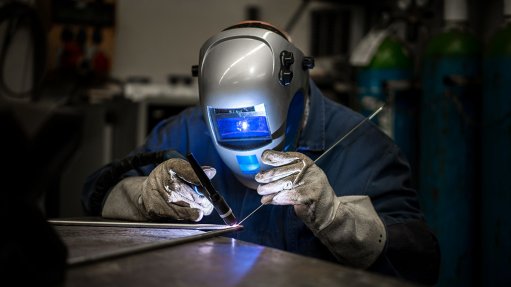
ENHANCED TRAINING CAPABILITIES The SAIW has a robotic welder, and now offers a robotic welding course. SAIW also has virtual welders that can be used to help train welders
Industry body Southern African Institute of Welding (SAIW) executive director John Tarboton stresses the need for more investment in local infrastructure to boost the prospects of the South African welding industry.
“The activity in the welding industry is determined by activity in manufacturing, mining and construction, as well as other sectors such as energy and petrochemicals. Therefore, while welding is an enabling technology that allows for the industrialisation of an economy to take place, it alone cannot drive industrialisation and economic growth.”
Tarboton maintains that South Africa has been “deindustrialising for some time”, and that there will need to be changes to the economic direction of the country to reverse this trend.
These changes need to make it easier for businesses to operate, as the cost of doing business in the country also needs to be lowered, he adds.
“This can be done by, for example, investing in eliminating loadshedding and ensuring that the administered price increases are lower than inflation. In this environment, the welding industry can thrive. For now, however, the outlook is one of stagnation.”
Keeping Up With Advances
Tarboton says there have been technological advances in welding processes in the local market, such as laser welding and friction stir welding, in addition to technologies that include robotic welding and virtual welding.
“The SAIW has a robotic welder, and we now offer a robotic welding course. We also have virtual welders that we use to help train welders. The virtual welder has a welding helmet and a welding gun, torch or electrode holder. With the helmet on, the welder is in a virtual environment where they can see the metal piece and perform the weld.”
Further, he states that the virtual welder can measure numerous variables to evaluate the welder trainee.
The virtual welder, while an ideal way of introducing a beginner to welding, can also be used to evaluate and improve the welding technique of experienced welders, adds Tarboton.
He confirms that SAIW would like to introduce a certified inspectors scheme in the future.
Currently, the SAIW offers SAIW Level 1 and Level 2 qualifications, as well as equivalent International Institute of Welding qualifications.
“However, we need to certify inspectors as being competent. We believe this will assist the industry in employing inspectors who can better meet their needs.”
The institute would also like to continue growing its client base for company certification, particularly for ISO 3834 – the quality requirements for fusion welding of metallic materials.
“We also see the mining sector as a key area that can drive growth. We would like to extend our training capabilities in nondestructive testing in the derived techniques of ultrasonic testing, such as phased array testing and time-of-flight diffraction testing,” he concludes.